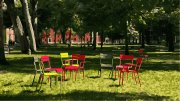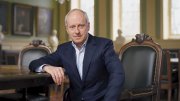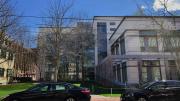Around a dozen students were already seated by the time I made it over to the grassy clearing in Harvard Yard. It was a Wednesday afternoon during finals week. A stone’s throw away, protesters tended to the pro-Palestinian encampment that stood sandwiched between two of our school’s most iconic administrative buildings.
I was there because I’d been invited to an informal gathering to share perspectives on Harvard’s response to the encampment and, more broadly, to the violence in the Middle East that had cast resounding shocks across our country in the past months. I was hesitant to attend. What ultimately convinced me was that the friend who had invited me was someone I admired fiercely, in large part because of her work in cultivating student-led spaces that afforded undergraduates the opportunity to wrestle with Harvard’s uncertain future in a context devoid of administrators or demands for rapid solutions. Amid all the chaos and hurt, I ached for a place to just be. I nursed the vague hope that this gathering might be it.
I’m not proud of the calculus that threaded my internal monologue as I eased myself into a swatch of wet grass: How much should I actually disclose? How can I trust that others won’t judge the dense knot of feelings I have around this issue, a knot I haven’t even had the mental energy to fully disentangle myself?
It was comforting to observe that others seemed to feel similarly. Some wrung their hands; others tapped their shoes to the ground. The student next to me, whom I’d never seen in my four years at the College, pulled up lumps of turf in seeming apprehension.
Then the friend who’d invited us cleared her throat and thanked us for coming. Her voice sounded nearly hoarse, waving shakily in the heavy silence. Our group was small enough that we went around and introduced ourselves one by one, saying our names and what had brought us there. Everyone had radically different postures toward the issues at hand—the pro-Palestinian encampment, Harvard’s response to it, and the war in the Middle East. Our single commonality was the peculiar combination of confusion and care we brought to the circle. It was as though we had all sought out this space not necessarily to talk but, more importantly, to feel less alone.
By the time we had gotten around the entire circle, some of our collective anxiety had melted. I could see it in our body language. Some people slouched a bit, relaxing into the grass. Others managed a smile as one of the attendees launched into an impassioned diatribe about a botched economics exam he’d taken earlier that day. After about an hour and a half of discussion, in which many people disagreed but always with tenderness and respect, we dispersed. Some rushed to Adams to catch the last of dinner; others hurried to Lamont or Widener. I drifted back to Pforzheimer House, walking slowly by the Science Center as the sky slipped into aubergine hues.
It’s hard to articulate the feeling I had as I walked back to the Quad in the twilight. The best I can put it is that I felt at once lighter and more solid than I had in a long time. It was like breathing a sigh that, though I hadn’t known it at the time, had been building in my throat for weeks.
Two features of the gathering buoyed me. First, it was entirely student-led and -attended. Gone were sympathetic administrators or deans who, though often well-meaning, changed the atmosphere of the conversation simply through their presence. Second—and perhaps most crucially—the conversation was entirely and deliberately undocumented. Nothing that anyone said on that grass was to be disclosed to others; no sound bites recorded or published on social media. There was no celebration of progress, no ledger of potential solutions the University could implement. This wasn’t a coincidence. It was purposeful in the meeting’s design, intended to ensure the highest degree of openness and candor.
I wondered then what we might have looked like to an unsuspecting bystander. Likely nothing special—just a gaggle of students milling about in the Yard. Yet, as quaint as the gathering may have seemed, it led me to a revelation about what was wrong with the ways in which my alma mater was being talked about and presented to those outside our gates.
When Harvard was launched into the national spotlight after October 7, everyone seemed to believe they knew exactly what Harvard was and in what direction it was headed. Many observers derived these judgments from what they saw on social media or read in national headlines. There are a few problems with this. For one, what—and who—constitutes “Harvard” differs largely from person to person. More importantly, though, these observers seemed to give little consideration to the fact that so much of what transpires at this school is not publicly visible. This failure, in our hyper-digital age, represents a larger cultural phenomenon: we’ve become alarmingly good at formulating complicated judgments on the tragic premise that everything we can’t see might as well not exist.
Let me paint an example. In mid-April, a friend of mine posted a panoramic video of a quiet Harvard Yard on X, the social media platform formerly known as Twitter. The video lasted for all of a couple seconds. In it, people from the encampment milled about, some playing music, others engaging inquisitive passersby in conversation. The grounds of Tercentenary Theater were barely populated; emerald leaves danced lazily as a group of kids tossed a Frisbee and students chatted on the steps of Widener. In the caption corresponding to his video, he remarked that, contrary to what the media seemed to suggest, Harvard’s campus was pretty serene.
My friend’s post wasn’t an attempt to undercut the strenuous work of student activists on either side of the ideological spectrum. Rather, it was intended to rouse bystanders—pundits; political partisans; academics; and all others who observe Harvard from the outside with a kind of salacious rapture, at once in awe of it and devoted to the prospect of its demise—from their hubristic misapprehension that they could know what Harvard really was, and what happens inside it. Harvard is not simply what people believe it should stand for. It is also classes and spontaneous encounters and conversations, many of which are largely unobserved, like the gathering I attended in the Yard. That gathering represented to me something important about the University: for all its pomp, Harvard’s truest and most generative power is unleashed when students take matters into their own hands—and not always in ways that garner public attention.
One of the courses I most cherished at Harvard was a graduate seminar on higher education and the law. I still remember my first walk to Longfellow, on the Graduate School of Education campus, climbing up two flights of stairs before walking gingerly into the seminar room at the back of the hall. I eased myself into a plastic swivel chair as sun beams spilled into the unlit space. Our professor, a partner and cofounder of a Boston-based sports and education law firm, strode in and smiled warmly before taking a seat. He then asked us to name the stakeholders of a university.
Everyone responded with what they believed to be the sharpest answers. Donors. Administrators. The public. Lobbyists and lawmakers who, for whatever reason, agitated in Washington for higher education reform. With each new answer, we created in real time the sketches of a dynamic ecology, all the vested interests and entities that collided to form the modern university. Our professor nodded patiently at each suggestion.
When we thought we had exhausted the list, we reclined in our seats, rather pleased with ourselves. Our professor gazed at us then, the ghost of a grin flickering across his face.
“What about you all?” he whispered.
Recent coverage of Harvard has often privileged—and been led by—every stakeholder within this University’s complex ecosystem except its most fundamental one: students. Megadonors publish scathing diatribes in an attempt to shape university policy. Influential professors do more of the same. Pundits pontificate giddily about the decline of a once venerated institution. To me, these words pale in the face of unobserved yet dignified conversations like the one I shared during finals week. This fortifies me and gives me hope.
A place like Harvard—indeed, most places that help shape our society—is attentive to what can be seen. Yet as I prepare for my next chapter, what I remember most from looking back will be those moments of quiet, undocumented fellowship with others who possessed enough humility and care to foster conversations that others, dismissing them as futile, didn’t even bother to begin. Some might find it wistful, even tragic, that many of Harvard’s finest moments go unseen. But in an epoch like this one, perhaps it’s a way of protecting something good.









